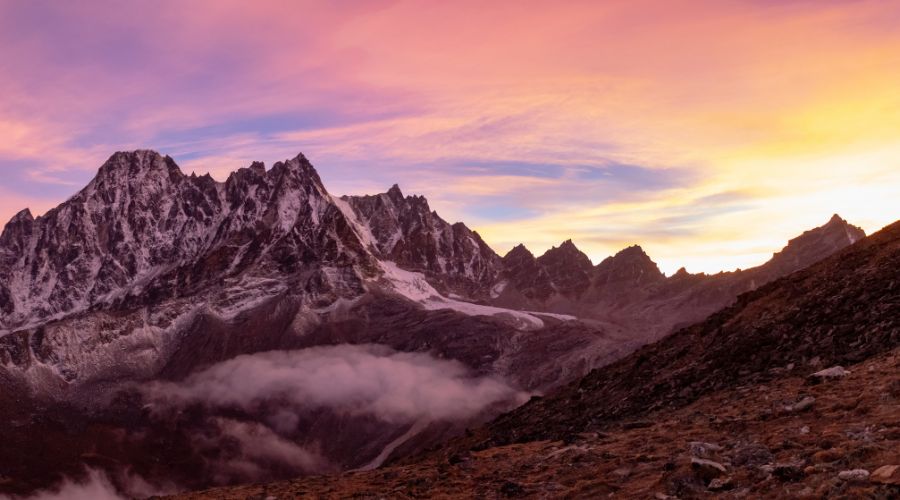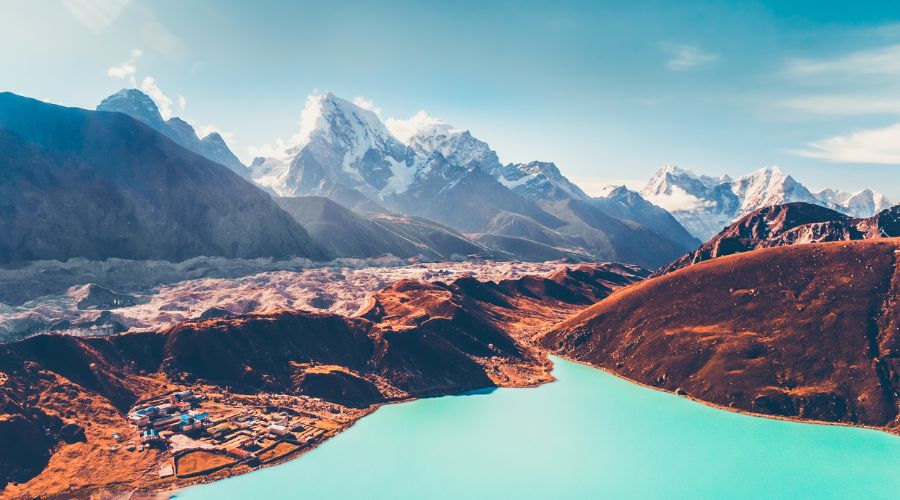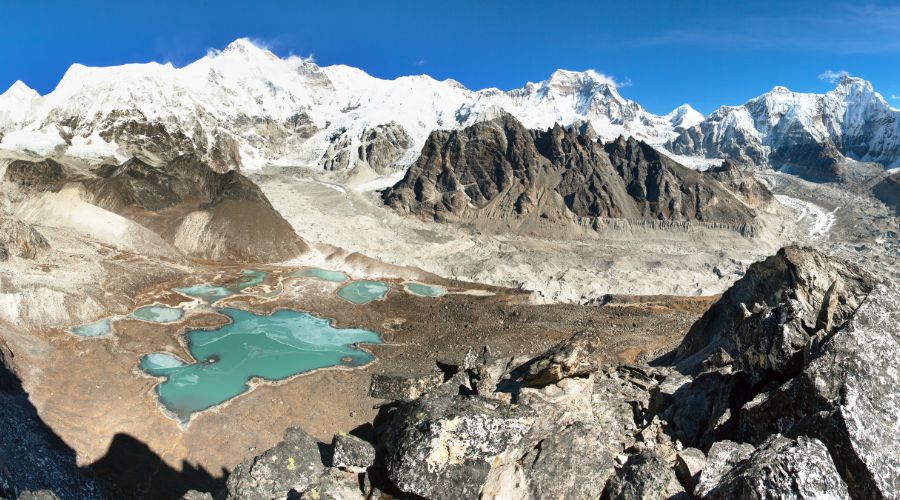.png)
Complete Guide to Gokyo Ri Trek

Complete Guide to Gokyo Ri Trek
swotah travel
2164
21, 01 2024
The Gokyo Ri Trek is a premier hiking destination in the Everest region, known for its scenic vistas and less-travelled paths. Gokyo Ri, with an elevation of 5,483 meters (17,986 feet), provides a compelling alternative to the Everest Base Camp Trek, attracting trekkers with its unique route. The trek encompasses the ascent to Gokyo Peak, standing at 5,357 meters (17,575 feet), and is renowned for its spectacular views of Everest (8,848.86 meters or 29,031 feet), Lhotse, Cho Oyu, and Makalu.

Breathtaking panoramic views from the summit of Gokyo Ri, where earth meets sky.
Starting from Lukla, the trek spans a distance of 30.9 kilometres (19.2 miles) and traverses through the Khumbu region's diverse landscapes. One of the trek's highlights is the Gokyo Valley, home to 19 lakes, including 16 freshwater ones, offering a serene and picturesque environment. The trek is not just a physical journey but also a cultural exploration, providing insights into the lifestyle and traditions of the local Sherpa community. The Gokyo Ri Trek is a must-try for those seeking an immersive experience in the Himalayas, combining natural beauty with cultural richness.
It is an alternative trek for those who want to be in the Himalayas but don't yet feel ready for more challenging ones like the Everest Base Camp trek and the Kanchenjunga Base Camp trek. However, this does not mean that the Gokyo Ri trek is easy. It is not beginner-friendly and has a high difficulty level. One does need good previous trekking experience to opt for it. Now, let's talk about the routes to arrive at Gokyo Ri
How exactly can you get to the Gokyo Ri?
There are two main routes to get to Gokyo Ri first via Lukla and second via Jiri. From Kathmandu’s Tribhuvan International, take a flight to Lukla. This takes about 35 minutes. The cost of the flights to Lukla is approximately $190 ( may be more or less depending on the time and airline). After arriving at Lukla route expands to Namche Bazar which is 13.5 km / 8.388511 miles away. This takes about 2 days, including acclimatising day. From Namche Bazar, the next destination is Dole, which is completed in about 7-hour long trek. Finally, you get to Gokyo through Machhermo which in total is about 8 hours to 9 hours OR first trek from Dole to Machhermo, take a rest day at Machhermro, and trek to Gokyo to next day. Follow the same route while returning from Gokyo to Kathmandu.
P.S: There are Helicopter rides from Kathmandu to Lukla as well. The price for a helicopter ride is around USD 900 per person.

The rugged beauty of the Gokyo Ri trail
If you wish to follow the trail via Jiri, first off take a bus from Kathmandu to Jiri( or hire a private vehicle like a jeep, van, etc.) Local bus takes about 7 hours to 8 hours to reach Jiri. The next day, trek to Bandar for about 4 to 5 hours. You can take a direct bus to Bandar, but the road condition is not very good so, we suggest you trek from Jiri to Bandar on foot.
Moving ahead the following day, you cross thado Khola via a bridge and trek up to Sete. The route now expands from Sete to Junbesi, it takes around 6 to 7 hours of trekking. Now trek moves to Nunthala, trekking for about 7 hours max gets you here from Junbesi. This day trail reaches Bupsa, walking about 5 hours to 6 hours is enough this day. Finally, you arrive at Namche Bazar from Bupsa by trekking for about 6 hours. From Namche Bazar, the route is the same as of Gokyo Ri via Lukla, that is Namche Bazar to Dole, Dole to Machhermo and Machhermo to Gokyo Ri.
Based on the provided information, here's a day-by-day itinerary for the Gokyo Ri Trek via both Lukla and Jiri routes:
Gokyo Ri Trek via Lukla
Day 1: Kathmandu to Lukla Flight, Trek to Phakding
-
Depart from Kathmandu’s Tribhuvan International Airport.
-
Take a 35-minute flight to Lukla; flight cost approx. $190 per person.
-
Start the trek from Lukla to Phakding.
Day 2: Phakding to Namche Bazar
-
Trek from Phakding to Namche Bazar (13.5 km/8.39 miles).
-
Overnight stay in Namche Bazar for acclimatization.
Day 3: Acclimatization Day at Namche Bazar
-
Spend the day in Namche Bazar to acclimatize.
Day 4: Namche Bazar to Dole
-
Trek for about 7 hours from Namche Bazar to Dole.
Day 5: Dole to Machhermo
-
Trek from Dole to Machhermo (8-9 hours total trek time).
Day 6: Machhermo to Gokyo
-
Trek from Machhermo to Gokyo.
Day 7: Gokyo Ri Ascent and Return
-
Ascent Gokyo Ri and return.
Day 8: Gokyo to Namche Bazar
-
Trek back from Gokyo to Namche Bazar.
Day 9: Namche Bazar to Lukla
-
Return trek from Namche Bazar to Lukla.
Day 10: Lukla to Kathmandu Flight
-
Flight back to Kathmandu from Lukla.
Gokyo Ri Trek via Jiri
Day 1: Kathmandu to Jiri
-
Take a local bus or hire a private vehicle to Jiri (7-8 hours).
Day 2: Jiri to Bandar
-
Trek from Jiri to Bandar (4-5 hours).
Day 3: Bandar to Sete
-
Trek across Thado Khola and up to Sete.
Day 4: Sete to Junbesi
-
Trek from Sete to Junbesi (6-7 hours).
Day 5: Junbesi to Nunthala
-
Trek from Junbesi to Nunthala (7 hours max).
Day 6: Nunthala to Bupsa
-
Trek to Bupsa (5-6 hours).
Day 7: Bupsa to Namche Bazar
-
Trek from Bupsa to Namche Bazar (6 hours).
Day 8: Acclimatization Day at Namche Bazar
-
Spend the day in Namche Bazar for acclimatization.
Day 9: Namche Bazar to Dole
-
Trek to Dole.
Day 10: Dole to Machhermo
-
Trek to Machhermo.
Day 11: Machhermo to Gokyo
-
Trek to Gokyo.
Day 12: Gokyo Ri Ascent and Return
-
Ascent Gokyo Ri and return.
Day 13: Gokyo to Namche Bazar
-
Trek back to Namche Bazar.
Day 14: Namche Bazar to Lukla
-
Return trek to Lukla.
Day 15: Lukla to Kathmandu
-
Flight back to Kathmandu.

Majestic view of the Himalayan sunset from Gokyo Ri, a moment of serene beauty.
Major Highlights of the Gokyo Ri Trek
-
Namche Bazar in itself, is one of the treasures of Nepal. It was formerly a trading spot now, known for its yak cheese factory, cultural and traditional practices, views of different mountains, etc.
-
To the west of the Gokyo peak there lies the largest glacier in the Khumbu region called Ngozumpa Glacier.
-
Besides the magnificent view of Mt.Everest, other 8000 m / 26246.72 ft plus snow-capped mountains are visible from Gokyo Ri, namely Mt. Makalu 8,481 metres (27,825 ft), Mt. Cho Oyu 8,188 metres (26,864 ft), and Mt.Lhotse 27,940 feet (8,516 metres) and other mountains like Mt.Pumori 7,161 m (23,494 ft), Mt.Ama Dablam 6,812 metres (22,349 ft), etc.
-
Gokyo Valley is known for Gokyo Lakes, there are a total of 19 lakes in Gokyo Valley. Most known among those are Gokyo Cho / Tsho aka Dudh Pokhari, Tanjung Cho, Ngojumba Cho, Kyajumba Cho, Thanok Cho, and Gyajumpa Cho. (Cho /Tsho is the Tibetan word for Lake)
-
Learn and be part of the hospitable, warm, and brave Sherpa’s lifestyle, culture, and traditions.
-
Trekking through off the beaten path with solitude. It is the less busy/crowded alternative for the Everest Base Camp trek for those who like trekking in peace.

The tranquil waters of Gokyo Lakes, reflecting the grandeur of the surrounding peaks.
When is the best time for the Gokyo Ri trek?
The safest time of the year for the Gokyo Ri trek is the Spring season (March, April, and May) and Autumn season (September, October, and November). During the months of spring, the trek trail is firm, and the temperature is moderate.
As spring starts after the winter season, the days are warm (not hot) and longer. The environment gets its livelihood back as vegetation starts getting back to life and flowers start blooming. As the weather is not at extreme levels during the Spring season there is less chance of any natural hazards. Similarly, in the case of Autumn days start cooling after scorching hot Summer days. Days are fairly hot whereas nights are a bit cooler as winter is around the corner. The atmosphere of leaves turning brown, and the color of festivities like Dashain and Tihar add so much more warmth to Autumn’s Gokyo trek.
If you are intrigued about the remaining two seasons namely Summer (Monsoon) season and Winter season. Well, the Gokyo Ri trek is very much doable during these seasons but there is a higher risk of getting caught middle of the trek and being the victim of natural calamities. How so you ask? The summer season is the rainy season of Nepal and is known for continuous heavy rainfall. So, naturally, the trail gets slippery, and there are higher probability of landslides and floods. There are high chances of trails being damaged by landslides so much so you may not be able to further and if you get caught in them you will be severely injured.
And in winter, the Himalayas are deadly cold. There are high chances of avalanches and snow storms. One can get frostbite and respiratory issues due to intense cold. So, if you do make up your mind for the Gokyo trek during the Winter or Rainy season check whether before leaving every day, and pack accordingly.

Here is a chart with the average temperature of each month in Gokyo Ri:
-
January -14.5 degrees Celsius / 5.9 degrees Fahrenheit
-
February -14 degrees Celsius / 6.8 degrees Fahrenheit
-
March -11 degrees Celsius / 12.2 degrees Fahrenheit
-
April -6.9 degrees Celsius / 19.58 degrees Fahrenheit
-
May -2.5 degrees Celsius / 27.5 degrees Fahrenheit
-
June 1.5 degrees Celsius / 34.7 degrees Fahrenheit
-
July 2.5 degrees Celsius / 36.5 degrees Fahrenheit
-
August 2 degrees Celsius / 35.6 degrees Fahrenheit
-
September 0.5 degrees Celsius / 32.9 degrees Fahrenheit
-
October -4.5 degrees Celsius / 23.9 degrees Fahrenheit
-
November -7 degrees Celsius / 19.4 degrees Fahrenheit
-
December -10 degrees Celsius / 14 degrees Fahrenheit
Note: This is the average temperature of Gokyo Valley, in the places with lower altitudes, the temperature is much higher.
What to pack for your Gokyo Ri trek / Advice
-
First and foremost make sure you have all the documents and permits. For Gokyo Ri tek you need a Sgarmatha National Park permit. This costs Nrs 115 / USD 0.87 per person for SAARC nationalities and Nrs 3000 / USD 22.62 per person for other country’s citizens.
-
Get your travel insurance done before starting the trek. Check for emergency helicopter evacuation included in your travel insurance.
-
Carry things to protect you from the sun like hats, scarves, gloves, and sunscreen.
-
For spring and summer carry light weight breathable trekking clothes like cotton t-shirts and trekking joggers. For rainy seasons make sure to carry an umbrella, raincoats, waterproof jackets, waterproof jackets, and rain boots. For the winter trek to Gokyo Ri carry warm jackets and sweaters, woolen caps, hot water bottles, and just everything to keep you warm.
-
Spend on good quality trekking shoes with good grip, and trekking sticks. It is wise to have a pair of crampons that help you make a firm walking grip on the snow.
-
There are high chances of getting lost in the Himalayas so, always carry navigation tools, like a compass or even just a physical map of the area.
-
Make sure to pack headlights headlamps, torches, power banks and extra batteries.
-
It is very important to stay hydrated, so do carry water bottles and water purifying tablets with you.
-
There are fair chances of getting altitude sickness/mountain sickness like HAPE/HACE so, remember to acclimatize enough to get your body to adapt with the altitude.
-
Carry a first aid box and put medicines that help prevent and cure mountain sickness.
Book Gokyo Ri Adventure with Swotah
.jpg)
15 Days Gokyo Ri Valley Trek in Everest
$2285$2400
Unveil the hidden gems of the Everest region with our 15-day Gokyo Ri Valley Trek. Ascend to 5,357 meters, visit the iconic Gokyo Lakes, and delve into the unique culture of the Sherpas. This trek offers an enticing alternative to the traditional Everest Base Camp route.
.jpg)
18 Days Gokyo Ri Valley Trek with Everest Base Camp
$2585$2700
Trek to new heights with our 18-day Gokyo Ri and Everest Base Camp adventure.
NEWSLETTER SIGNUP
Sign up to receive our trip ideas and travel offers!
Get updates and Exclusive Offers up to 20% Discount








